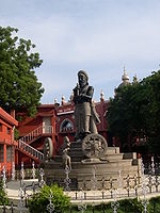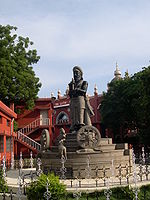
Manu Needhi Cholan
Encyclopedia

Chola Dynasty
The Chola dynasty was a Tamil dynasty which was one of the longest-ruling in some parts of southern India. The earliest datable references to this Tamil dynasty are in inscriptions from the 3rd century BC left by Asoka, of Maurya Empire; the dynasty continued to govern over varying territory until...
king believed to have killed his own son to provide justice to a Cow, following Manu Needhi or Manu's law. Legend has it that the king hung a giant bell in front of his courtroom for anyone needing justice to ring. One day, he came out on hearing the ringing of the bell by a Cow. On enquiry he found that the Calf of that Cow was killed under the wheels of his chariot
Chariot
The chariot is a type of horse carriage used in both peace and war as the chief vehicle of many ancient peoples. Ox carts, proto-chariots, were built by the Proto-Indo-Europeans and also built in Mesopotamia as early as 3000 BC. The original horse chariot was a fast, light, open, two wheeled...
. In order to provide justice to the cow, he killed his own son under the chariot as a punishment to himself i.e. make himself suffer as much as the cow. His name has since then been used as a metaphor for fairness and justice in Tamil literature
Tamil literature
Tamil literature refers to the literature in the Tamil language. Tamil literature has a rich and long literary tradition spanning more than two thousand years. The oldest extant works show signs of maturity indicating an even longer period of evolution...
. His capital was Thiruvarur.
Chronicles such as the Yalpana Vaipava Malai
Yalpana Vaipava Malai
Yalpana Vaipava Malai is a book written by a Tamil poet called Mayilvagana Pulavar 1736 AD. This book contains historical facts of the early Tamil city of Jaffna. The book which may have been written around 1736 during the Governorship of Jan Maccara, the then Dutch Governor of Jaffna. It was...
and stone inscriptions like Konesar Kalvettu recount that Kulakkottan, an early Chola king and descendant of Manu Needhi Cholan, was the restorer of the ruined Koneswaram temple
Koneswaram temple
Koneswaram temple of Trincomalee is an Hindu temple in Trincomalee, Eastern Province, Sri Lanka venerated by Saivites throughout the continent...
and tank at Trincomalee
Trincomalee
Trincomalee is a port city in Eastern Province, Sri Lanka and lies on the east coast of the island, about 113 miles south of Jaffna. It has a population of approximately 100,000 . The city is built on a peninsula, which divides the inner and outer harbours. Overlooking the Kottiyar Bay,...
in 438 A.D., the Munneswaram temple
Munneswaram temple
Munneswaram temple is an important regional Hindu temple complex in Sri Lanka, a predominantly Buddhist country. It has been in existence at least since 1000 CE, although myths surrounding the temple associate it with the popular Indian epic Ramayana, and its legendary hero-king Rama...
of the west coast, and as the royal who settled ancient Vanniyars in the east of the island Eelam
Eelam
Eelam also spelled Eezham, Ilam or Izham in English is the native Tamil name for the South Asian island state of Sri Lanka. Eelam is also a name for the spurge , toddy and gold. The exact etymology and the original meaning of the word are not clearly known, although there are number of...
.
Manu Needhi was also called as DharmaRajan. In the 'MahaVamsa', a historical poem of the Kings of Sri Lanka, tells of a Chola King who had identities similar to ManuNeedhi. MahaVamsa states that a King called Elara
Elara
Elara may refer to one of the following:*Elara , a moon of Jupiter*Elara , the mother of Tityas in Greek mythology*Elara , an ancient Sri Lankan king...
, a Chola King invaded the island in around 235 BC. It also adds that, he ruled 'with even justice toward friend and foe, on occasions of disputes at law,[1] and elaborates how he even ordered the execution of his son the basis of a heinous religious crime. The same chronicle relates that the king had a bell with a rope attached at the head of his bed, so that all who sought redress might ring it.In particular he is presented as a tireless defender of the native faith and of pointedly treating native Sinhala nobles with the same dignity as his Tamil associates. As such Elara is often held as the archetype of the Dharmaraja, or 'just king' of Buddhist tradition, all the more remarkable for not being a native son of the kingdom he governed.
From this Chronicle, The King's ordering of execution of his own son, and having a bell of justice can be related to Manu needhi's actions of killing his son for showing justice to the Cow and the bell which cow rang, as found in the first paragraph.

